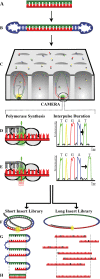Single molecule real-time (SMRT) sequencing comes of age: applications and utilities for medical diagnostics
- PMID: 29401301
- PMCID: PMC5861413
- DOI: 10.1093/nar/gky066
Single molecule real-time (SMRT) sequencing comes of age: applications and utilities for medical diagnostics
Abstract
Short read massive parallel sequencing has emerged as a standard diagnostic tool in the medical setting. However, short read technologies have inherent limitations such as GC bias, difficulties mapping to repetitive elements, trouble discriminating paralogous sequences, and difficulties in phasing alleles. Long read single molecule sequencers resolve these obstacles. Moreover, they offer higher consensus accuracies and can detect epigenetic modifications from native DNA. The first commercially available long read single molecule platform was the RS system based on PacBio's single molecule real-time (SMRT) sequencing technology, which has since evolved into their RSII and Sequel systems. Here we capsulize how SMRT sequencing is revolutionizing constitutional, reproductive, cancer, microbial and viral genetic testing.
Figures

References
-
- Vermeesch J.R., Voet T., Devriendt K.. Prenatal and pre-implantation genetic diagnosis. Nat. Rev. Genet. 2016; 17:643–656. - PubMed
Publication types
MeSH terms
Substances
LinkOut - more resources
Full Text Sources
Other Literature Sources
Medical
Miscellaneous

